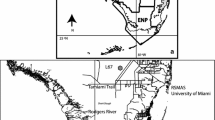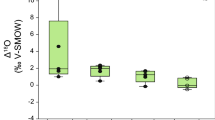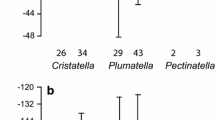Abstract
Museum collections contain a wealth of insect remains originating from a wide geographic range, which can be used to investigate their utility as a proxy for environmental isotope ratios. Chitinous remains of insects such as beetles (Coleoptera) are chemically stable and their stable isotope composition is strongly related to that of environmental water in the period of cuticle formation. We present a dataset of chitin δD and δ18O in two genera of water beetles from a museum collection containing 40 locations for Helophorus (water scavenging beetles) and 48 locations for Hydroporus (predaceous diving beetles) that were selected from latitudes 27–82°N in North America. Only two genera were used to minimize inter-sample variation caused by species-specific differences in metabolic effects, feeding strategy, habitat, and life cycle. The isotopic composition of water beetle exoskeletons had a strong latitudinal trend (North–South) from −160 to +65 ‰ for δD and from 7 to 34 ‰ for δ18O, paralleling gradients of isotopes in precipitation. Strong relationships were observed between isotopic composition of beetles and modelled July precipitation (0.71 < R 2 < 0.82, p < 0.001). The relationship between δD and δ18O in the beetle samples had a systematic offset from the global meteoric water line, which was likely caused by metabolic effects during chitin formation. The offset between δD values in beetles and in modelled precipitation was 33 ‰ larger, on average, for Hydroporus compared with Helophorus, suggesting fractionation of hydrogen isotopes during passage through the food chain. This trophic level effect was not observed for stable oxygen isotopes. Furthermore, the observed deviations between isotopic composition of water beetles and modelled precipitation at collection sites were not constant and indicated local hydrological deviations from modelled precipitation. The largest deviations were observed for sites in the Southern US and the Arctic that are highly evaporative and at sites in the Rocky Mountains and Coastal Mountains that were fed by snow melt. Our results indicated that the isotopic composition of water beetles from a museum collection was systematically related to δD and δ18O values of precipitation at the collection site.



Similar content being viewed by others
References
Anderson L, Abbott MB, Finney BP, Burns SJ (2005) Regional atmospheric circulation change in the North Pacific during the Holocene inferred from lacustrine carbonate oxygen isotopes, Yukon Territory, Canada. Quat Res 64:21–35
Barker PA, Street-Perrott FA, Leng MJ, Greenwood PB, Swain DL, Perrott RA, Telford RJ, Ficken KJ (2001) A 14,000-year oxygen isotope record from diatom silica in two Alpine Lakes on Mt. Kenya. Science 292:2307–2310
Birchall J, O’Connell TC, Heaton THE, Hedges REM (2005) Hydrogen isotope ratios in animal body protein reflect trophic level. J Anim Ecol 74:877–881
Bowen GJ, Revenaugh J (2003) Interpolating the isotopic composition of modern meteoric precipitation. Water Resour Res 39:1299
Bowen GJ, Wilkinson B (2002) Spatial distribution of δ18O in meteoric precipitation. Geology 30:315–318
Bowen GJ, Wassenaar LI, Hobson KA (2005) Global application of stable hydrogen and oxygen isotopes to wildlife forensics. Oecologia 143:337–348
Burnett AW, Kirby ME, Mullins HT, Patterson WP (2003) Increasing Great Lake: effect snowfall during the twentieth century—a regional response to global warming? J Clim 16:3535–3542
Dansgaard W (1964) Stable isotopes in precipitation. Tellus 16:436–468
Dutton A, Wilkinson BH, Welker JM, Bowen GJ, Lohmann KC (2005) Spatial distribution and seasonal variation in δ18O of modern precipitation and river water across the conterminous USA. Hydrol Process 19:4121–4146
Eicher U, Siegenthaler U (1976) Palynological and oxygen isotope investigatins on Late-Glacial sediment cores from Swiss lakes. Boreas 5:109–117
Elias SA (2006) Quaternary beetle research: the state of the art. Quat Sci Rev 25:1731–1737
Gasse F (2005) Isotopic palaeolimnology. In: Aggarwal K, Gat JR, Frohlich KFO (eds) Isotopes in the water cycle. Springer, Dordrecht, pp 353–358
Gat JR (1995) Stable isotopes of fresh and saline lakes. In: Lerman A, Imboden DM, Gat JR (eds) Physics and chemistry of lakes. Springer, Berlin, pp 139–195
Gibson JJ (2002) Short-term evaporation and water budget comparisons in shallow Arctic lakes using non-steady isotope mass balance. J Hydrol 264:242–261
Gibson JJ, Edwards TWD (2002) Regional water balance trends and evaporation-transpiration partitioning from a stable isotope survey of lakes in northern Canada. Glob Biogeochem Cycles 16:1026. doi:10.1029/2001GB001839
Gibson JJ, Edwards TWD, Birks SJ, Amour NA, Buhay WM, McEachern P, Wolfe BB, Peters DL (2005) Progress in isotope tracer hydrology in Canada. Hydrol Process 19:303–327
Gibson JJ, Birks SJ, Edwards TWD (2008) Global prediction of δA and δ2H–δ18O evaporation slopes for lakes and soil water accounting for seasonality. Glob Biogeochem Cycles 22:GB2031. doi:10.1029/2007GB002997
Gröcke DR, Schimmelmann A, Elias S, Miller RF (2006) Stable hydrogen-isotope ratios in beetle chitin: preliminary European data and re-interpretation of North American data. Quat Sci Rev 25:1850–1864
Hammer Ø (2012) Past, paleontological statistics version 2.14, reference manual. Natural History Museum, University of Oslo, Oslo
Hammer Ø, Harper DAT, Ryan PD (2001) PAST: paleontological statistics software package for education and data analysis. Palaeontol Electr 4:9
Hedges REM, Stevens RE, Koch PL (2006) Isotopes in bone and teeth. In: Leng MJ (ed) Isotopes in palaeoenvironmental research. Springer, Dordrecht, pp 117–145
Henderson AK, Shuman BN (2009) Hydrogen and oxygen isotopic compositions of lake water in the western United States. Geol Soc Am Bull 121:1179–1189
Hobson KA, Atwell L, Wassenaar LI (1999a) Influence of drinking water and diet on the stable-hydrogen isotope ratios of animal tissues. Proc Natl Acad Sci USA 96:8003–8006
Hobson KA, Wassenaar LI, Taylor OR (1999b) Stable isotopes (δD and δ13C) are geographic indicators of natal origins of monarch butterflies in eastern North America. Oecologia 120:397–404
IAEA/WMO (2006) Global network of isotopes in precipitation. The GNIP database. Accessible at: http://www.iaea.org/water
Larson DJ, Alaire Y, Roughley RE (2000) Predaceous diving beetles (Coleoptera: Dytiscidae) of the Nearctic Region, with emphasis on the fauna of Canada and Alaska. NRC Research Press, Ottawa
Leng MJ, Barker PA (2006) A review of the oxygen isotope composition of lacustrine diatom silica for palaeoclimate reconstruction. Earth-Sci Rev 75:5–27
Miller RF, Fritz P, Morgan AV (1988) Climatic implications of D/H ratios in beetle chitin. Palaeogeogr Palaeoclimatol Palaeoecol 66:277–288
Nielson KE, Bowen GJ (2010) Hydrogen and oxygen in brine shrimp chitin reflect environmental water and dietary isotopic composition. Geochim Cosmochim Acta 74:1812–1822
Reynard LM, Hedges REM (2008) Stable hydrogen isotopes of bone collagen in palaeodietary and palaeoenvironmental reconstruction. J Archaeol Sci 35:1934–1942
Rozanski K, Araguás-Araguás L, Gonfiantini R (1993) Isotopic patterns in modern global precipitation. Geophys Monogr 78:1–36
Sauer PE, Miller GH, Overpeck JT (2001) Oxygen isotope ratios of organic matter in arctic lakes as a paleoclimate proxy: field and laboratory investigations. J Paleolimnol 25:43–64
Schimmelmann A, DeNiro MJ (1986) Stable isotopic studies on chitin. III. The D/H and 18O/16O ratios in arthopod chitin. Geochim Cosmochim Acta 50:1485–1496
Schimmelmann A, Miller RF (2002) Review of methods for the determination of deuterium/hydrogen stable isotope ratios in chitin. In: Muzzarelli RAA, Muzzarelli C (eds) Chitosan in pharmacy and chemistry. Atec Edizioni, Grottammare, pp 469–474
Schimmelmann A, Miller RF, Leavitt SW (1993) Hydrogen isotopic exchange and stable isotope ratios in cellulose, wood, chitin, and amino compounds. Geophys Monogr 78:367–374
Shuman B, Huang Y, Newby P, Wang Y (2006) Compound-specific isotopic analyses track changes in seasonal precipitation regimes in the Northeastern United States at ca 8,200 cal yr BP. Quat Sci Rev 25:2992–3002
Smetana A (1985) Revision of the subfamily Helophorinae of the Nearctic region (Coleoptera: Hydrophilidae). Mem Entomol Soc Can 131:1–154
Smith MA, Hollander DJ (1999) Historical linkage between atmospheric circulation patterns and the oxygen isotopic record of sedimentary carbonates from Lake Mendota, Wisconsin, USA. Geology 27:589–592
Solomon C, Cole J, Doucett R, Pace M, Preston N, Smith L, Weidel B (2009) The influence of environmental water on the hydrogen stable isotope ratio in aquatic consumers. Oecologia 161:313–324
Soto DX, Wassenaar LI, Hobson KA, Catalan J (2011) Effects of size and diet on stable hydrogen isotope values (δD) in fish: implications for tracing origins of individuals and their food sources. Can J Fish Aquat Sci 68:2011–2019
Verbruggen F, Heiri O, Reichart GJ, Blaga C, Lotter AF (2011) Stable oxygen isotopes in chironomid and cladoceran remains as indicators for lake-water δ18O. Limnol Oceanogr 56:2071–2079
von Grafenstein U, Erlenkeuser H, Brauer A, Jouzel J, Johnsen SJ (1999a) A Mid-European decadal isotope-climate record from 15,500 to 5,000 years BP. Science 284:1654–1657
von Grafenstein U, Erlernkeuser H, Trimborn P (1999b) Oxygen and carbon isotopes in modern fresh-water ostracod valves: assessing vital offsets and autecological effects of interest for palaeoclimate studies. Palaeogeogr Palaeoclimatol Palaeoecol 148:133–152
Wang Y, O’Brien D, Jenson J, Francis D, Wooller M (2009) The influence of diet and water on the stable oxygen and hydrogen isotope composition of Chironomidae (Diptera) with paleoecological implications. Oecologia 160:225–233
Wassenaar LI, Hobson KA (2003) Comparative equilibration and online technique for determination of non-exchangeable hydrogen of keratins for use in animal migration studies. Isot Environ Health Stud 39:211–217
Wolfe BB, Falcone MD, Clogg-Wright KP, Mongeon CL, Yi Y, Brock BE, Amour NA, Mark WA, Edwards TWD (2007) Progress in isotope paleohydrology using lake sediment cellulose. J Paleolimnol 37:221–231
Wooller MJ, Francis D, Fogel ML, Miller GH, Walker IR, Wolfe AP (2004) Quantitative paleotemperature estimates from δ18O of chironomid head capsules preserved in arctic lake sediments. J Paleolimnol 31:267–274
Yu Z, Ito E, Engstrom DR (2002) Water isotopic and hydrochemical evolution of a lake chain in the northern Great Plains and its paleoclimatic implications. J Paleolimnol 28:207–217
Acknowledgments
The museum specimens were kindly provided (i.e. sacrificed) by Dr. P. Bouchard and Mr. A. E. Davies at the Canadian National Collection of Insects, Agriculture and Agri-Food Canada. We thank Jonathan Holmes and three anonymous reviewers for their constructive remarks on earlier versions of this manuscript. Support for van Hardenbroek’s dissertation research was provided by a NERC training grant NE/E522959/1. This project was supported by a grant from the Natural Sciences and Engineering Research Council of Canada Discovery Grant to DRG (No. 288321).
Author information
Authors and Affiliations
Corresponding author
Electronic supplementary material
Below is the link to the electronic supplementary material.
Rights and permissions
About this article
Cite this article
van Hardenbroek, M., Gröcke, D.R., Sauer, P.E. et al. North American transect of stable hydrogen and oxygen isotopes in water beetles from a museum collection. J Paleolimnol 48, 461–470 (2012). https://doi.org/10.1007/s10933-012-9623-4
Received:
Accepted:
Published:
Issue Date:
DOI: https://doi.org/10.1007/s10933-012-9623-4




